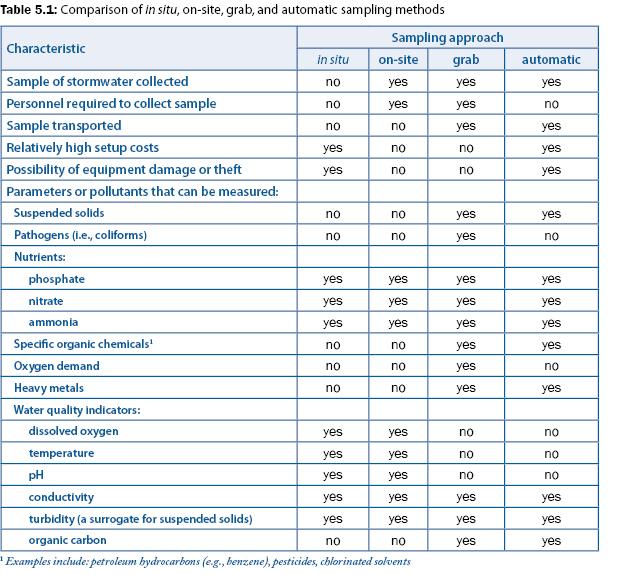
Sampling Methods
P.T. Weiss, A.J. Erickson, J.S. Gulliver, R.M. Hozalski, O. Mohseni, and W.R. Herb
The effectiveness of a stormwater treatment practice at capturing a pollutant or pollutants can be assessed by comparing the amount of pollutant that enters the stormwater treatment practice to either the amount of pollutant that exits the stormwater treatment practice (by subtraction) or to the amount that is retained. Pollutants are measured in mass or concentration, and these measurements can be taken using one of four methods. First, pollutants can be measured and recorded in situ, or in place, using pollutant sensors or probes placed directly in the stormwater runoff to collect near-continuous measurements with respect to time (in situ sampling). The measurements are later downloaded to a computer by an individual on site or via cell phone connection. Second, stormwater samples can be collected manually and analyzed on site with sensors, probes, or by other analytical methods (on-site sampling). Third, a sample can be collected manually in the field and transported back to a laboratory for analysis (“grab” sampling). Fourth, stormwater runoff can be collected with an automatic sampler, retrieved at a later time, and analyzed in a laboratory (automatic sampling). Some advantages and disadvantages of each method are given in table 5.1. For more information on sampling methods, consult Standard Methods (A.P.H.A. 1998b), “Urban Stormwater BMP Performance Monitoring” (U.S. EPA. 2002), or “Wastewater sampling for process and quality control (Manual of practice)” (WEF 1996).

In situ sampling is advantageous in that data can be collected frequently, in small time steps, with the results available remotely (e.g., cellular phone connection) once the sampling equipment is installed. Another advantage of in situ sampling is that it can be used to measure some of the water quality parameters that are likely to change during sample storage or transport, such as pH or dissolved oxygen. Although personnel are not required to collect samples or perform the chemical analyses, someone must periodically (e.g., weekly) visit the site to maintain and re-calibrate the equipment. Unfortunately, a different probe or sensor is required for each pollutant being measured, and not all pollutants can be measured with sensors or probes. For example, nutrient measurement technology is currently cumbersome, with potential improvements that are currently research topics (Arai et al. 2009). There are available, however, in situ bundles that include several common probes and sensors used in water quality assessment.
On-site sampling can also be used to measure water quality parameters that are likely to change during transport. Setup costs for onsite sampling are minimal because it does not require that any equipment remain in the field. Nevertheless, on-site sampling requires individuals to collect samples and perform the analysis on site.
Grab sampling is advantageous for parameters that cannot be accurately, or quickly, measured in the field or in situ (e.g., phosphorus). Grab sampling also does not require any equipment to remain in the field and be susceptible to damage from the weather or vandalism. Portable pumps and tubing may be used to collect samples from locations that are difficult to access, such as the bottom of an underground proprietary device or the center of a wet pond. The primary advantage of grab sampling is that set-up costs are small. Nevertheless, flow measurement equipment must be installed because pollutant removal efficiency and effluent pollutant loads cannot be determined without discharge measurements. The disadvantages of grab sampling include: (1) inconvenience and cost of sending a crew to the site to collect samples during a storm event and (2) lack of an ability to perform flow-weighted sampling.
Automatic sampling requires someone to set up the sample collection system, periodically retrieve the samples from the sampler, and transport the samples to a laboratory for analysis. The time spent in the field for automatic sampling after sampler installation is minimal because automatically-collected samples from a storm event can be retrieved and the automatic sampler reset within a few minutes. Automatic samplers are the most common for stormwater monitoring operations, because of the ability to accurately sample nutrients and heavy metals.
Choosing from in situ, on-site, grab, and automatic sampling will depend on budget constraints, personnel availability, and the goals of the assessment program. There are four levels of assessment, listed in order of increasing complexity: visual inspection, capacity testing, synthetic runoff testing, and monitoring. Visual inspection (level 1) is the only level of assessment that does not require sampling. Capacity testing (level 2) for hydraulic conductivity determination often requires samples for soil moisture measurements at each location. The procedures and related sampling required to measure soil moisture is discussed in Analysis of Water and Soils. Some stormwater treatment practices for which synthetic runoff testing is applicable may require sampling of the influent or effluent synthetic runoff, or both. In these cases, the sampling methods for synthetic runoff testing are the same as the sampling methods for monitoring. The rest of this section (Sampling Methods) discusses the sampling methods required for synthetic runoff testing and for monitoring.
The following five key questions should be considered when incorporating sampling into an assessment program:
- How many storm events should be sampled to make statistically accurate estimates of performance?
- How many samples should be collected per storm event?
- When multiple samples are collected per storm event, should they be collected based on discharge amount, elapsed time, or a user-defined basis?
- When multiple samples are collected per storm event, should they be collected in individual bottles (discrete samples) or combined into a single bottle (composite samples)?
- Should stormwater runoff be sampled in situ, on-site, manually (i.e., grab), or automatically?
The next several sections provide discussion and recommendations for each of the above criteria that should be thoroughly considered before sampling is included in any assessment program:
- Representative Samples
- Number of storm events
- Samples per storm events
- In situ, on-site, and grab, and automatic sampling
- Additional considerations for automatic sampling
- Sample handling
Continue to Representative Samples.